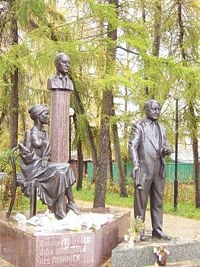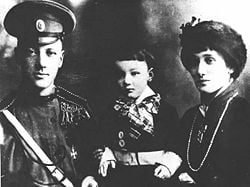Lev Gumilev
Lev Nikolayevich Gumilyov (Russian: Лев Никола́евич Гумилёв) (October 1, 1912, St. Petersburg–June 15, 1992, St. Petersburg), also known as Lev Gumilev, was a Russian historian. His unorthodox ideas on the birth and death of ethnoses (ethnic groups) have given rise to the political and cultural movement known as "Neo-Eurasianism."
Life
His parents were two prominent poets, Nikolay Gumilev and Anna Akhmatova. They divorced when Lev was 7 years old, and his father was executed because of his anti-bolshevik sympathies when Lev was just 9. During his mother's persecution in the 1930s, he was expelled from the Leningrad University and deported to gulags, where he would spend most of his youth, from 1938 until 1956. During a brief stint at large, he joined the Red Army and took part in the Battle of Berlin. In order to secure his release, Akhmatova was forced to publish dithyrambs to Stalin, but this didn't help. Their relations remained strained, as Lev blamed his mother for the misfortunes that had dogged his youth.
After Stalin's death, Gumilev joined the Hermitage Museum, whose director, Mikhail Artamonov, he would come to appreciate as his mentor. Under Artamonov's guidance, he became interested in Khazar studies and steppe peoples in general. In 1950s-1960s he participated in several expiditions to the Volga Delta and North Caucasus. He proposed a archeological site for Samandar as well as the theory of the Caspian transgression in collaboration with geologist Aleksandr Alyoksin as one of the reasons for Khazar decline.[1] In 1960 he started delivering lectures at the Leningrad University. Two years later, he defended his doctor's thesis on ancient Turks. From the 1960s, he worked in the Geography Institute, where he would defend another doctoral thesis, this time in geography.
Although his ideas were rejected by the official Soviet doctrine and most of his monographs banned from publication, Gumilev came to attract much publicity, especially in the period of Perestroika during the Gorbachev era. As an indication of his popularity, the Kazakh president Nursultan Nazarbayev ordered the Lev Gumilev Eurasian University to be erected just opposite his own palace on the central square of new Kazakh capital, Astana.
Ideas
Gumilev attempted to explain the waves of nomadic migration that rocked the great steppe of Eurasia for centuries by geographical factors such as annual vacillations in solar radiation, which determine the area of grasslands that could be used for grazing livestock. According to this idea, when the steppe areas shrank drastically, the nomads of Central Asia began moving to the fertile pastures of Europe or China.
To describe his ideas on the genesis and evolution of ethnoses, Gumilev introduced the concept of "passionarity," which may be explained as the level of vital energy and power characteristic of any given ethnic group. Gumilev argued that they pass through stages. The stages include: rise, development, climax, inertial, convolution, and memorial. It is during the "acmatic" phases, when the national passionarity reaches its maximum heat, that the great conquests are made. The current state of Europe he described as deep inertia, or "introduction to obscuration," to use his own term. The passionarity of the Arabic world, on the other hand, is still high.
Drawing inspiration from the works of Konstantin Leontyev and Nikolay Danilevsky, Gumilev regarded Russians as a "super-ethnos" which is kindred to Turkic peoples of the Eurasian steppe. Those periods when Russia has been said to conflict with the steppe peoples, Gumilev reinterpreted as the periods of consolidation of Russian power with that of steppe in order to oppose destructive influences from Catholic Europe, that posed a potential threat to integrity of the Russian ethnic group.
Legacy
In accordance with his pan-Asiatic theories, he supported the national movements of Tatars, Kazakhs, and other Turkic peoples, in addition to those of the Mongolians and other East Asians. Not surprisingly, Gumilev's teachings have enjoyed immense popularity in Central Asian countries. In Kazan, for example, a monument to him was opened in August 2005.
Accusations of anti-Semitism
Gumilev did not extend this ethnological ecumenism, however, to the medieval Jews, who he regarded as a parasitic, international urban class that had dominated the Khazars who in turn had subjected the early East Slavs to the "Khazar Yoke." This last phrase he adapted from the traditional term "Tatar Yoke" for the Mongol domination of medieval Russia, a term Gumilev rejected for he did not regard the Mongol conquest as a necessarily negative event. In particular, and with virtually no support from primary sources, he asserted that the Radhanites had been instrumental in the exploitation of East Slavic people and had exerted undue influence on the sociopolitical and economic landscape of the early Middle Ages. Gumilev maintained that the Jewish culture was by nature mercantile and existed outside and in opposition to its environment. According to this view, the Jews are not a nation, but a specific way of thinking by a certain group of people having Jewish genetic heritage and/or sharing the moral norms of Judaism.[2][3][4] These ideas have led scholars such as Vadim Rossman, John Klier, Victor Yasmann, Victor Shnirelman, and Mikhail Tripolsky to label Gumilev antisemitic.[5]
Works
- The Hsiung-nu (1960)—on the Xiongnu
- Ancient Turks (1964)
- Searching for an Imaginary Kingdom : The Legend of the Kingdom of Prester John (1970)
- The Hsiung-nu in China (1974)
- Ethnogenesis and the Biosphere of Earth (1978)
- Ancient Rus and the Great Steppe (1989)
- An End and a New Beginning (1989)
- From the Rus to Russia (1992)
ReferencesISBN links support NWE through referral fees
- ↑ (Russian) Лев Гумилёв. Открытие хазарии. Москва. Айр Пресс, 2006.
- ↑ Выбор веры (Russian)
- ↑ Tripolsky, Mihail. ОБ ИЗВРАЩЕНИИ ИСТОРИИ: Хазарский каганат, евреи и судьба России
- ↑ Rossman, Vadim. The Ethnic Community and Its Enemies: Russian Intellectual Antisemitism in the Post-Communist Era
- ↑ Shnirelman, Victor A. "The Story of a Euphamism: The Khazars in Russian Nationalist Literature." The World of the Khazars: New Perspectives. Brill, 2007. p. 353-372; Rossman, Vadim, et al. Russian Intellectual Antisemitism in the Post Communist Era (Studies in Antisemitism Series). Univ. of Nebraska Press, 2005; Malakhov, Vladimir. "Racism and Migrants." (Trans. Mischa Gabowitsch.) Neprikosnovennij Zapas, 2003; Klier, John. "The Myth of the Khazars and Intellectual Antisemitism in Russia, 1970s–1990s." The Slavonic and East European Review, Volume 83, Number 4, 1 October 2005, pp. 779-781(3). See also, e.g., FSU Monitor Russia Regional Report 2001; Yasmann, Victor. "The Rise of the Eurasians." The Eurasian Politician Issue 4 (August 2001) Radio Free Europe, 1992; Yasmann, Victor. "Red Religion:An Ideology of Neo-Messianic Russian Fundamentalism" Demoktratizat: The Journal of Post-Soviet Democratization. Volume 1, No. 2. p. 26.
See also
- Igor Diakonov
External links
- Gumilevica: All about Gumilev
- The criticism towards the West and the future of Russia-Eurasia by Galya Andreyeva Krasteva at The Eurasian Politician
Credits
New World Encyclopedia writers and editors rewrote and completed the Wikipedia article in accordance with New World Encyclopedia standards. This article abides by terms of the Creative Commons CC-by-sa 3.0 License (CC-by-sa), which may be used and disseminated with proper attribution. Credit is due under the terms of this license that can reference both the New World Encyclopedia contributors and the selfless volunteer contributors of the Wikimedia Foundation. To cite this article click here for a list of acceptable citing formats.The history of earlier contributions by wikipedians is accessible to researchers here:
The history of this article since it was imported to New World Encyclopedia:
Note: Some restrictions may apply to use of individual images which are separately licensed.

